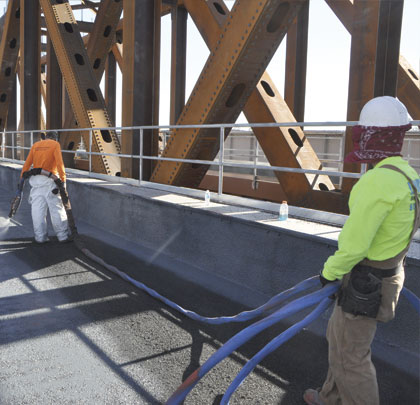Arecent 60 Minutes TV broadcast—“Falling Apart”—explains that “America’s roads, bridges, airports, and rail lines are outdated and need to be fixed.” It also states that “nearly 70,000 bridges in America—one out of every nine—is now considered to be structurally deficient.” The problem with much of America’s infrastructure is that it has outlived its intended service life, while failure of traditional waterproofing coatings has led to a significant corrosion of structural elements, including corroded rebar and crumbling concrete.
Luckily, a new category of spray-applied waterproofing products that is seamless, rugged, fast curing, impervious to water, able to bridge cracks, and capable of lasting decades without extensive maintenance is available. “Spray-applied waterproofing now accounts for more than 50 percent of the membranes applied to our bridges,” says Alexander Bardow, P.E., MassDOT’s state bridge engineer, Massachusetts representative on AASHTO’s subcommittee on bridges and structures, and past president of Boston Society of Civil Engineers Section of ASCE.
Drawbacks of Traditional Techniques
While traditional methods of waterproofing, such as emulsions, sheet goods, or non-elastomeric coatings, have long been used, they have significant drawbacks. According to Bardow, in past decades, MassDOT utilized mopped emulsion reinforced with fiberglass fabric for bridge decks before turning to sheet goods. “Our experience showed that reinforced emulsion was not a good deck waterproofing system because it debonded,” says Bardow. “Water could get underneath it and into the deck. We turned to prefabricated sheet-applied membranes. These were easy to apply, but we wanted more durability.” As for non-elastomeric coatings like epoxies and paints, these do not have the elasticity to bridge cracks and are moisture-resistant rather than truly waterproof.
“Spray-applied waterproofing membrane is the next step after sheet membrane,” says Bardow. “It gives us better performance and has measurable performance characteristics that we can count on for extended deck life. We expect spray-applied waterproofing membranes to last about 30 to 50 years.”
Spray-Applied Waterproofing
Some spray-applied elastomer waterproofing systems have coefficients of linear thermal expansion similar to concrete and steel, the most common bridge building materials. This physical property is an important prerequisite to ensuring success when membranes are used as a composite with layers of asphalt. “Spray-applied waterproofed materials like BDM can last 5 decades or more,” says Traci Micucci, president of Eastern Bridge Works, a Poughkeepsie, New York-based waterproofing contractor. “That would eliminate repeatedly tearing up the asphalt overlay, resealing the deck, and repaving it. It would stop rebar corrosion and concrete spalling in decks to keep infrastructure safely operating.”
These spray-applied membranes can be sprayed horizontally, vertically, and overhead at any thickness. Spray-applied waterproofing can also be applied robotically with greater speed and consistency than other materials. “By robot, we can consistently spray-apply waterproof more than 10,000 square feet of deck per day with BDM at 80-85 mils on any surface,” says Ted Predki, chief estimator and project manager at Pine Waterproofing and Sealant.
As a waterproofing contractor, Predki also prefers the spray-applied waterproofing approach for its fast set and curing times. “The waterproofing can set in 10 seconds so you can walk on it,” says Predki. A CDOT project in downtown Chicago, recently completed by Pine Waterproofing, involved applying 65,000 square feet of spray-applied waterproofing and needed to be returned to service as quickly as possible. The concrete surface was extremely rough, but BDM was still able to achieve a superior bond. The contractor was able to install over 30,000 square feet of 80 mils BDM and 40 mils of top coat with aggregate within 7 days, completing the job within 4 weeks.
“When we did the Metra Fast 14 project, we had to complete a bridge project in essentially one weekend, explains Bardow. “Within than time, we had to demolish the existing bridge, set prefabricated bridge units for the new bridge, do all the closure pours, have the concrete set, then come back to spray-apply waterproofing membrane. The contractor accomplished this. The speed of spray-applied membrane installation was an important factor in meeting the accelerated deadline.”
INSPIRING INNOVATION
Spray-applied waterproofing also opens the door to complementary technologies. Bridge joints, as an example, are a typical location for the development of leaks. They can now be completely waterproofed with spray-applied technology. Articulus, a flexible expansion joint system developed by Bridge Preservation, offers seamless waterproofing protection for joint openings. When used in conjunction with spray-applied waterproofing membranes, these expansion joints form a high-strength chemical bond that forms a single, monolithic layer of waterproofing across both the joints and bridge deck.
Protection board for railroad bridges is another area of recent innovation. Integrated Ballast Mat, a spray-applied ballast mat also developed by Bridge Preservation, provides seamless, high-build protection of the waterproofing system with a secondary ballast protection course. It also provides additional waterproofing protection and enhanced electrical resistivity. It passes the North American Ballast Impact Test, and can accept ballast loading one hour after application. For flat decks it can also be applied at varying thickness to provide slope for drainage.
“With spray-applied waterproofing technology designed to reliably last decades without ongoing maintenance, civil and structural engineers have a valuable new tool that can help them cost-effectively maintain critical infrastructure while minimizing downtime,” says Micucci. ■
For More Information: For more information, visit www.bridgepreservation.com.
_________________________________________________________________________
Modern Contractor Solutions, October 2015
Did you enjoy this article?
Subscribe to the FREE Digital Edition of Modern Contractor Solutions magazine.

Maintaining Critical Road, Rail, and Bridge Infrastructure


